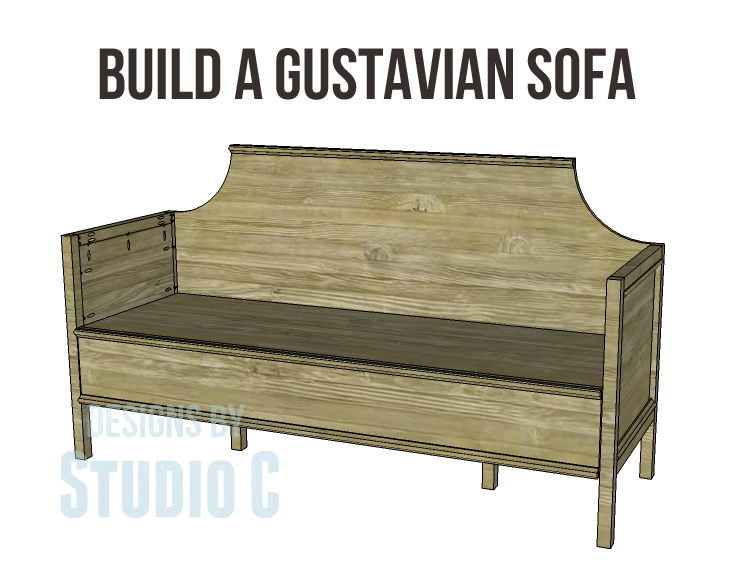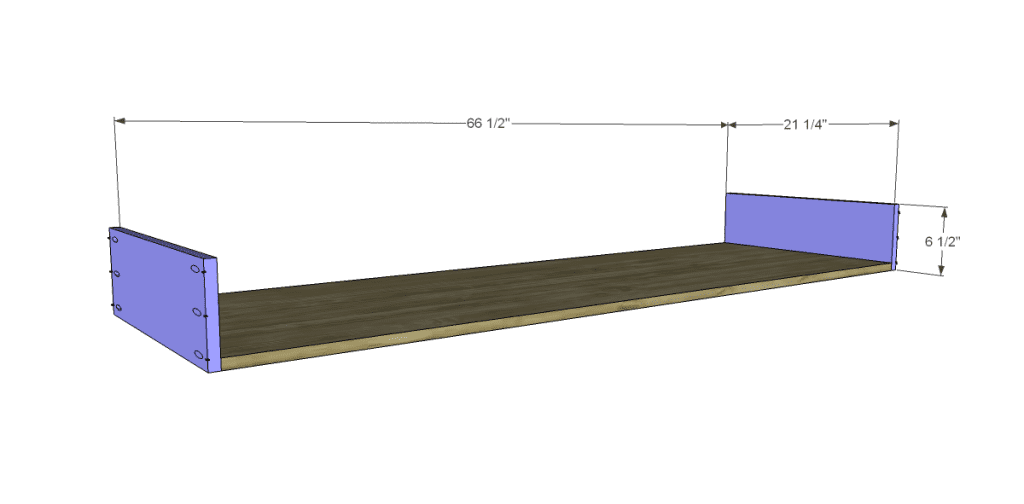An Easy to Build Sofa with Storage
Today’s plan is for a really cool storage sofa that would look fabulous in an entryway or mud room. The large drawer under the seat will provide plenty of storage for shoes, backpacks, or other odds and ends. The plans to build a Wisteria-inspired Gustavian sofa are easy to construct and certainly won’t break the bank!

Materials:
- 1-1/4″ pocket hole screws
- 2-1/2″ pocket hole screws
- 1-1/4″ brad nails
- 1-1/2″ screws
- 2″ screws
- Edge banding for plywood, optional (<– affiliate link!)
- One set of 22″ drawer slides
- Finishing Supplies
Lumber:
- 3 – 2×2 at 8′
- 3 – 1×2 at 8′
- 2 sheets of 3/4″ plywood
- Trim of your choice
Cut List:
- 4 – 2×2 at 30″ – Legs
- 4 – 2×2 at 20-3/4″ – Side Frames
- 2 – 3/4″ plywood at 19″ x 20-3/4″ – Side Panels
- 2 – 2×2 at 8″ – Support Legs
- 1 – 3/4″ plywood at 23″ x 69″ – Bottom
- 1 – 3/4″ plywood at 31-1/4″ x 69″ – Back
- 5 – 1×2 at 20-3/4″ – Seat Frame
- 2 – 1×2 at 69″ – Seat Frame
- 1 – 3/4″ plywood at 22-1/4″ x 69″ – Seat
- 1 – 3/4″ plywood at 21-1/4″ x XX” – Drawer Bottom*
- 2 – 3/4″ plywood at 6-1/2″ x 21-1/4″ – Drawer Sides*
- 1 – 3/4″ plywood at 6-1/2″ x XX” – Drawer Back*
- 1 – 3/4″ plywood at 10″ x 68-3/4″ – Drawer Front*
* = See Step 6 for drawer instructions before cutting!

Step One
If using edge banding, it will be applied to the exposed edges of the plywood before assembly.
Cut the pieces for the side frames and panels, then drill pocket holes in the pieces as shown. Attach the frame pieces to the side panels using glue and 1-1/4″ pocket hole screws. Attach the assembly to the legs using glue and 1-1/4″ pocket hole screws through the holes in the panels, and 2-1/2″ pocket hole screws through the holes in the frame. The back side of the panels will be flush with the inside face of the frame pieces and legs.

Step Two
Cut the piece for the bottom and support legs. Attach the support legs using glue and countersunk 2″ screws through the bottom into the legs. Use at least two screws per leg. Drill pocket holes in the shorter ends of the bottom and secure to the side frames using glue and 2-1/2″ pocket hole screws.

Step Three
Cut the piece for the back. Cut the arcs in each side maintaining the dimensions as shown. Drill pocket holes in the sides and lower edge. Attach to the bottom and legs using glue and 1-1/4″ pocket hole screws.

Step Four
Cut the piece for the seat frame. Drill pocket holes in each end of the shorter pieces. Assemble as shown using glue and 1-1/4″ pocket hole screws. Position the frame as shown then secure using 1-1/2″ screws through the frame into the sides and back.

Step Five
Cut the piece for the seat. Secure to the frame using glue and 1-1/4″ brad nails.

Step Six
Before cutting the pieces for the drawer, install the cabinet side drawer slides according to the manufacturer’s instructions. Refer to this easy tutorial on installing drawer slides. Make any necessary adjustments.
Sandra from Sawdust Girl gave an excellent piece of advice I didn’t think of before – install the cabinet side slides first, then measure for the width of the drawer. I cannot tell you how many times I’ve followed my instructions (ha!) and my drawers were either slightly tight or loose. I’m going to follow her advice from now on!
Measure from the inside of one drawer slide to the inside of the other drawer slide. This will be the width of the drawer box. The dimensions for the length of the drawer box assembly will not change, nor will the dimensions for the drawer front.
Cut the pieces and drill pocket holes in each end of the side pieces as well as all four edges of the bottom. Assemble as shown using glue and 1-1/4″ pocket hole screws. The fronts will overlap the drawer box by at least 3/8″ on each side.

 Step Seven
Step Seven
I did not include measurements for the trim. The trim will be measured and cut according to the finished bench. The inspiration piece has trim on the curved edges of the back. It would be easy to make your own trim as follows:
Trace the arc on 3/4″ lumber of your choice. Offset the arc by 3″ and cut out two pieces. Clamp to the back of the bench and measure the distance between them for the upper trim piece. Drill pocket holes in each edge of the straight piece and attach to the arc trim using glue and 1-1/4″ pocket hole screws. Use a router to cut a decorative edge on the outside edge as well as the inside edge of the trim. Secure to the back using glue and 1-1/4″ brad nails. Trim for the side panels and drawer front can be created in the same manner.

Finish as desired.
This would be a great storage sofa for the deck or porch! Pillows or cushions could be hidden in the drawer to keep them clean when not in use. Have any questions about the plans to build a Gustavian sofa? Leave a comment below!
Originally posted 2014-05-05 08:00:31.





7 Comments
Excellent instructions. Now, to see if I can talk hubby into it. Me? Nah, I’m not creative with my hands. Unless you’re talking about writing. Followed you from SITS.
Send him over… I’ll see what I can do! Ha ha! Thank you for stopping by!
Thank you for sharing the how-to. I love Gustavian furniture. Pinning this for hopefully future project! Lucy
Thank you very much, Lucy! I love the Gustavian style, too! I appreciate you stopping by!
I do you have any suggestions how to possibly upholster it? I love the plan and especially the back and the drawer is two thumbs up! As mother of six, I am always looking for more storage!
Hi, Aelizabeth! I would suggest a basic box cushion for the seat and throw pillows for the back… Hope this helps!